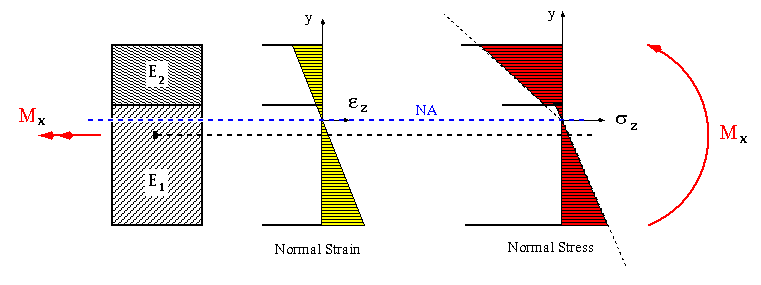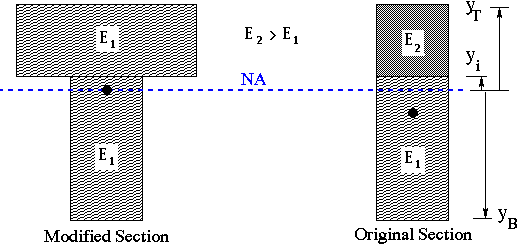


Considering a section made of two different materials with Young's moduli identified by E1 and E2 and with stresses below the elastic limit of each material, we can write

Where yB is the distance from the NA to the bottom surface, yi is the distance from the NA to the material interface and yT is the distance to the top surface. Using the linear equation for strain variation gives

Factoring out the common terms and E1 gives

A close examination of this equation reveals that the bracketed term must be equal to zero. However, the ratio of E2 to E1 in front of the second term inside the brackets indicates that neutral axis will pass through the centroid of the modified homogeneous section, one with material 2 replaced with an equivalent material 1. This fact is captured in the figure below with the condition that E2 > E1.

Notice that only the width of the section is modified while its height is kept the same. This condition would have been reversed if the bending moment was applied about the vertical axis.
The moment equation is written as

For the case of a section made of two different materials, as shown above,
the integral is divided into two parts, one for each elastic material. Notice
that y is measured from the neutral axis.

Using the linear normal strain variation we get

Factoring out the constant terms and normalizing with respect to E1 we get

The terms inside the brackets represent the moment of inertia of the modified homogeneous section about the neutral axis, and can be expressed as

Substituting this into the previous equation and solving for the stress gives

This equation can be used to calculate the bending stress only for the portion that is made of material 1. To calculate the bending stress in the portion that is made of material 2, it should be multiplied by the ratio of Young's moduli of the two materials as

The procedure described above is known as the Modified Section Method, and is used in the analysis of elastic non-homogeneous beam sections in bending.
 To Section II.4
To Section II.4